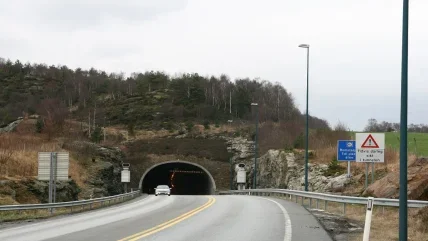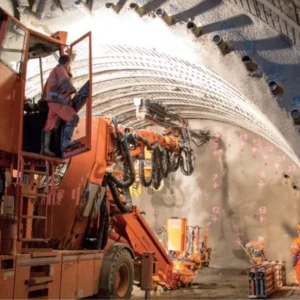
Research led by Norway is improving the understanding and performance of highpressure grouting in tunnels through a combination of work by academics, a PhD, and site-based studies on construction projects. The research has been building upon empirical field experience to scientifically optimise the approaches for pre-excavation grouting (PEG) to reduce groundwater ingress and achieve specified leakage limits.
A major, recently-completed research project is the four-year initiative called TIGHT (True Improvement in Grouting High Pressure Technology for Tunnelling). TIGHT’s official report was issued in Norwegian in 2020. While it has been presented locally, including to the Norwegian Tunnelling Society’s (NFF) Fjellsprengningsdagen conference, held virtually and organised by Tekna in November 2020, the findings will be shared internationally from 2021.
A follow-on research commercialisation project, Logic Grouting, is underway and aims to produce software tools to improve planning and execution of PEG, and so to help with the financial and environmental performance of tunnel projects. T&T discussed the research studies with Prof Eivind Grov, project leader on TIGHT with research body SINTEF, and his colleague Helene Stromsvik.
Other Norwegian researchers on TIGHT included the Norwegian University of Science and Technology (NTNU) and the Norwegian Geotechnical Institute (NGI), and they worked in collaboration with others from Sweden, South Korea and Singapore. The Norwegian national road and rail transport authorities plus a number of industrial suppliers and local contractors were also involved. TIGHT looked at drill and blast projects in the research but its findings on the way forward for grouting also apply to TBM projects under similar circumstances, Grov tells T&T.
The research outcomes suggest, he says, that the Norwegian approach to grouting “would preferably” shift to detailing more focused, site-specific designs and procedures, and that likewise tunnellers internationally should consider similar changes. He adds that the key audience for the findings so far, and the new research underway, are tunnel designers and clients, but contractors too, to help them choose how best to reduce leakage and perform grouting.
TIGHT
TIGHT combined the study of both theory and practical tunnelling to analyse the interplay of multiple variables in grouting, such as materials, equipment, geology, rock mechanics, experience and expertise in the field, including the use of sensors, as well as various monitoring and control procedures.
It also sought to better understand the threshold, the tipping point of hydraulic jacking, when high-pressure flow suddenly widens cracks in a local rock mass. Grouting operations then become more challenging as pressures and flow rates vary rapidly. Consequently, grout may be partly diverted from the target zones and, as such, more is needed to meet leakage limits.
Grov says that TIGHT shows the use of high-pressure grouting will continue even with hydraulic jacking risk. High pressure is a double-edged sword, he adds: “You need pressure to obtain penetration, while on the other hand, too high a pressure could cause fracturing.”
While some may view high flow-rates of grout to be a good thing, enabled by jacking, it may not always be effective to fill crack zones and reduce leakage. More focus is needed to stop excessive grouting, which will help reduce cost, time and environmental impact (CO2 footprint as well as the volume of cementitious material grouted) while achieving desired leakage rates.
The TIGHT research found that more caution is needed to ensure the effective spread of grout for given local conditions of in-situ rock stress, overburden and other elements that may cause resistance to its penetration.
TIGHT Studies
TIGHT was organised under work packages (WP 1-10) with management, state of the art benchmarking of grouting, understanding rock mass, and reporting, covered by WP 1-2 and 9-10, respectively. Technical studies were advanced under WP 4-8, looking at laboratory tests of cement mixes; numerical modelling and simulation of grout spread; recording data (pressure, flow rate, etc); and documentation. WP 3 – performed laboratory tests of cement-based grout mixes at different temperatures, finding some unexpected results. Similar products from different suppliers behaved differently, and with additives the results were unpredictable.
The findings emphasise that both the materials and mixing equipment for a project must be tested together.
WP 4 – looked at grout flow and pressure distribution using numerical analysis, and focused on single-phase liquids (resulting in particle size as being the dominant variable) but also some two-phase liquids (with displaced water as the other dominant variable). Researchers found the angle of borehole incidence-to-crack-orientation to have little influence on the spread of grout, and that viscosity has more effect. But the point of penetration in the crack needs to be open enough to permit, and not throttle, the flow of grout. Water in cracks was found to have some positive effect on grout dispersion.
WP 5 – developed a numerical grouting model based on theoretical formulas, like in WP4, but also used real site data to get information on rock mass fracture systems and to pinpoint instances of jacking. Researchers think models have potential to be project tools for describing rock mass. The method would require continuous rheology data during the grouting, and more research is required.
WP6 – created a scaled laboratory model for grouting and also performed cement testing. The latter confirmed work done in WP3, that finding optimal cement mixtures is challenging. The scale model was developed after some iterations but not in time to provide sufficient data during TIGHT, but it is available for future studies.
WP7 – building on work started before TIGHT, the research looked at full-scale testing onsite with instrumentation for downhole datalogging and documenting instances of jacking. Fewer hydraulic connections were found between grout holes than expected from the geology, though pressure logging revealed where there were links. All the data was not interpreted by the end of TIGHT. The research has potential to help determine rock-mass stresses, and so improve our understanding of local rock mechanics.
WP8 – focused on monitoring while documenting grouting in the rock mass. The research used ground penetrating radar (GPR) to scan a few radial boreholes where PEG had been performed previously, and grout placement was cross-checked by camera. While the results proved the method to be effective, there is no good tool to map crack systems in detail prior to grouting. But researchers believe GPR has exciting potential. Further research could look at monitoring grout spread during active injection. Construction projects in Norway that helped with field research for TIGHT included Follobanen, Kongsberg and Lyshorn tunnels, plus data from previous projects.
In addition, postgraduate studies including a PhD and seven master’s degrees were performed under TIGHT, and more master’s studies are underway.
Summary of Main Findings
The report says jacking is a recurring theme that often impacts time, cost and efficiency from grouting activities. However, it adds that jacking is not the core problem but rather control of the grout injection procedures that follow immediately following such instances.
High pressure is not the only criterion to manage for better grouting performance – the grout itself must also be considered. However, the report finds no simple answer on how best to choose a cement or mix design, for sometimes products with seemingly the same properties behave differently. It was also found there was variation between laboratory and field test results of some colloidal mixes.
The research findings suggest Norway, at least, should review its approaches but that widespread, uniform and generalised methods of grouting are not possible. The report calls instead for better, wholly project-specific solutions. They would have a comprehensive approach – continuously using the same cement-mix design for grout, the same mixing method and equipment, and faster more rigorous management controls of jacking risk – to minimise variations in grouting performance.
Optimal injection strategies can be developed for individual projects, but not generally, the TIGHT study suggests.
PHD Spotlight On Jacking
While jacking is not the core problem, the report says rock-mass conditions and the grouting pressures and operations may trigger such instances, resulting in it remaining an unpredictable risk. Under TIGHT, the question of handling this risk along with comparing practices to desired outcomes was considered in PhD research entitled ‘Assessment of High Pressure Pre-Excavation Rock Mass Grouting in Norwegian Tunnelling’, conducted by NTNU’s Stromsvik and supervised by Grov.
The PhD research drew upon the various work-package studies plus field work at the Follobanen project, where the rail authority commissioned a sequence of drilling and measurements in pre-grouted tunnels. The conclusions of the research suggest that better knowledge of crack systems are needed, on a continuous basis, to help reduce both jacking and excess consumption of grout. It was also found that grout penetration was less than suggested by laboratory tests, and hydraulic transmissivity was higher in granitic gneiss as opposed to finer-grained rock, such as amphibolite.
Separately, reviews of logs of six past tunnel projects show jacking to be common to PEG work in Norway. Pressure build-up is faster with micro-cement compared to industrial (Ordinary Portland) cement due to rheology, affecting the grouted volumes achieved.
The PhD study also considered grout consumption versus geological parameters but the latter lacked baseline data. The studies also looked at defining pressure against jacking risk, and an algorithm was developed to pinpoint and log such instances, generating more data for analysis.
A conclusion from the PhD study is that in leakage terms alone the current practice of PEG, and also follow-on grouting in tunnels, is reasonably good under normal ground conditions. However, grouting effectiveness needs to consider impacts on project/contract economics and environmental performance.
Road Ahead
The report says the findings under TIGHT should help support both technology development and benefit project performance on the time and cost aspects of grouting. There is scope to investigate contract conditions to better reflect grouting quality and quantity.
But while TIGHT may have been a long research project, it was too short to solve all key questions and future work requires continued knowledge sharing and access to tunnel projects, as given “selflessly” to TIGHT by various partners, says Grov in the report.
Particular steps for further research could include: using the scale-laboratory model; undertaking more data recording, especially of jacking, to help refine methods of rock stress assessment; and, more work with the GPR tool and numerical modelling, respectively.
“It is fair to say that Norway and Sweden are leading the way within this field,” Grov says.
The next research project is Logic Grouting, which began recently and runs to the end of 2022. It aims to develop marketable tools to interpret occurrences of jacking onsite, and online software to do statistical analysis for live decision making on projects. Logic Grouting involves some of the same partners plus new partners.
The research projects could help improve the technical and financial feasibility of some tunnel projects with more use of PEG to control leakage and less reliance on in-situ concrete lining with waterproof membranes, Grov says. Possibilities of this approach are suggested by previous success on the HATS2A sewerage project in Hong Kong.
With more studies and also greater generation of data on projects, Grov sees scope for deeper data analyses on grouting using artificial intelligence, especially as computing and sensor capabilities rise as costs drop.






